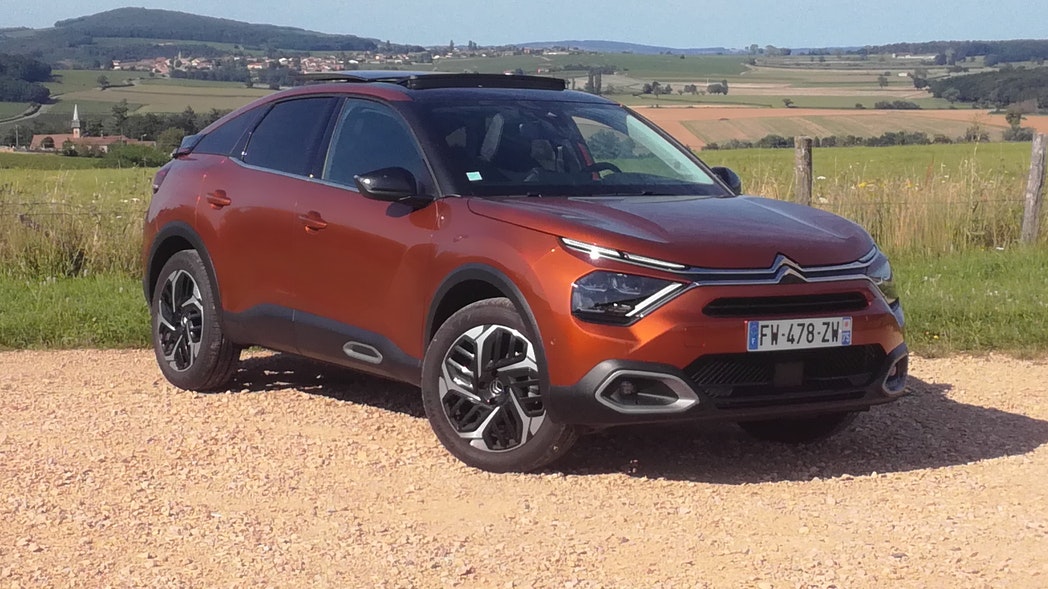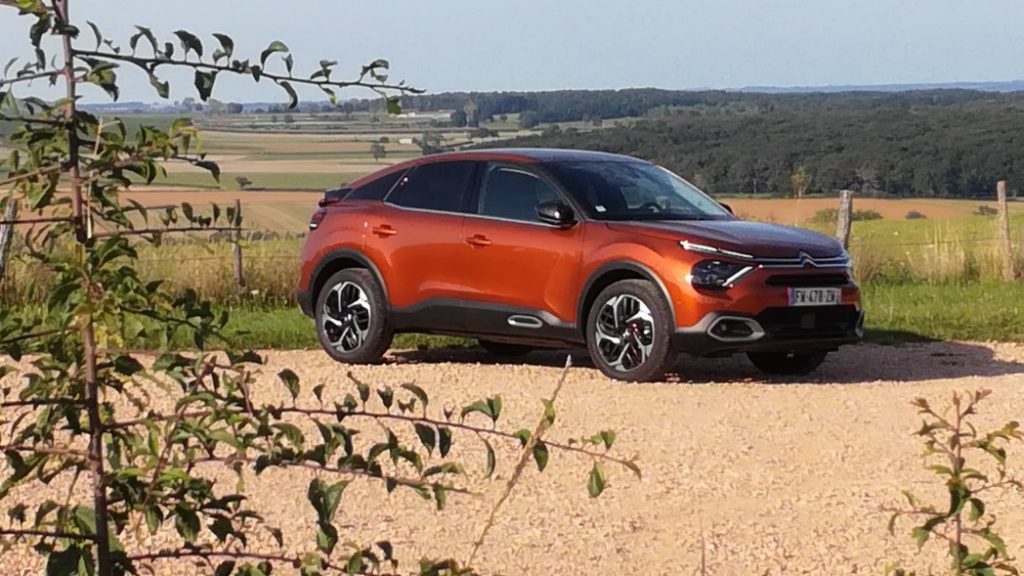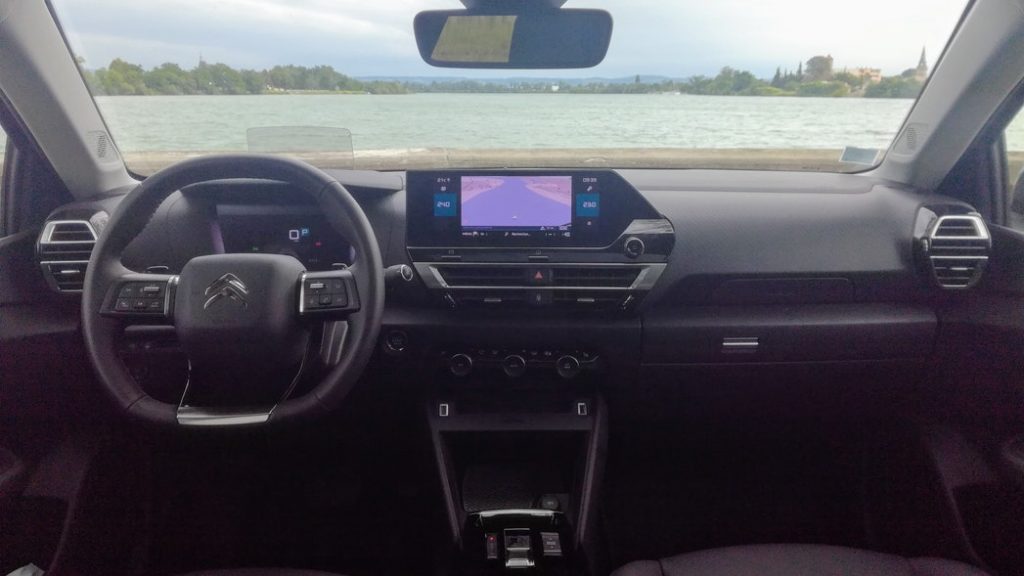Saying that the second generation Citroën C4 has had a turbulent career is an understatement. Born in 2010, the French compact car has indeed undergone major changes within the PSA group, including the harsh split between Citroën and DS Automobiles in 2015. After this date, Citroën became an essential brand forced to revise its ambitions downwards. The very timid facelift of 2015 is a clear reflection of this cruel cost-cutting. To make matters worse, in the second half of its career, the C4 suffered from internal competition from the C4 Cactus as well as from the rise of the SUVs that came to put obstacles in its path. This explains the moderate success of the car, which has sold some 600,000 units in eight years. Today, the French brand intends to renew its success through a third generation with a new design that announces a return to its roots. Successful gamble or clumsy decision?
Portrait – Did you say weird?
Enlarged by 3 cm compared to its predecessor, the new C4 is 4.36 m long, making it as long as the Mégane. The Citroën also claims a much stronger stylistic commitment. Is it a trendy SUV, a family hatchback or a stylish coupé? Perhaps all three at once, who knows? A real mishmash on wheels, the C4 fully assumes its ambiguous positioning and breaks completely with the previous model’s overly conservative design. The front, for example, features atypical Y-shaped daytime running lights, while the rear is as original as possible with a window split in two by a black lacquered spoiler. The taillights are made up of a double layer alternating between diagonal, flat and concave surfaces. The result is an original assembly, to say the least. However, it would be too easy to say that this C4 has invented everything. The sloping roofline, for example, has been taken directly from the famous GS!
In the cabin – Surprisingly restrained
After the surprise of the exterior, you would expect to find the same stylistic audacity on board. If so, you’ll be disappointed, because the little Citroën is more reasonable and puts forward a dashboard with a surprisingly wise design. In fact, the whole cabin does not offer anything unusual for a Citroën model, which in itself is really unusual. The quality of the materials is quite good if you don’t look at the lower parts. The same goes for the assemblies, which do not suffer from any notable criticism for the category. The seats of our model in the “Shine Pack” trim are entirely covered in leather with a rather coarse grain and a slightly stiff feel. The centre console and the base of the infotainment screen are covered in a black lacquered plastic that is certainly chic but very dirty to the touch and no less sensitive to scratches. The whole thing is a good sign, though. By offering physical air conditioning controls, the C4 is bucking the trend towards all-touch technology, to the benefit of ergonomics.
These controls also reflect a good quality feel, with nicely damped ventilation knobs and power window buttons. The same goes for the steering wheel switches, which are well adjusted and have a suitably calibrated resistance. As for the steering wheel, it’s pleasant to hold, with a rim that’s neither too thin nor too thick and full-grain leather that looks good. Passengers will be disappointed with the roof handles, which are not very pleasant to touch. The doors, however, produce a solid sound when closed, both at the front and at the rear. They also cover the lower part of the body, thus preventing you from getting your trousers dirty when you get out of the car.
Concentrated on a small 5-inch screen, the digital instrument cluster groups together only the essentials such as speed, traffic sign recognition, range, gear engaged and adaptive cruise control. The tachometer and engine temperature gauges are almost unreadable. Fortunately, the device is backed up by a colour head-up display that is far more readable. The centrally located 10-inch touchscreen manages the infotainment system. Equipped with the previous generation of the PSA system, it is now naturally outdated. If the graphics are just about decent, the reactivity is not there. And as on the previous models of the group, the temperature display permanently eats away at both ends of the screen, leaving a useful diagonal of 7 inches. The story is the same for the GPS, which is no longer up to date and suffers from quite a bit of clipping. We therefore strongly recommend the use of Apple CarPlay or Android Auto. Unfortunately, you have to use a USB-C socket to take advantage of this feature… We’ll console ourselves with the particularly large and numerous storage compartments. The boot is average with a volume of 380 litres, while the rear seats offer acceptable legroom and headroom.
On the road – A tribute to comfort?
The progressive hydraulic cushions. It is true that Citroën relies heavily on this technology to sell its models. The brand claims in its advertising that the system promises a flying carpet effect with a level of comfort worthy of the greatest. So, does the C4 flies on the road like its ancestor the GSA? Yes and no. At low speeds, the system does not absorb bumps any better than Citroëns equipped with conventional suspension. In the city, you don’t fly over manhole covers, cobblestones and other speed bumps, you just smooth them out. This does not mean that the C4 is uncomfortable, far from it, the car is really soft. We only expected a little more smoothness as promised by the brand. At higher speeds, however, the famous suspension becomes more meaningful, turning road bumps into minor jolts. This impression is reinforced by the Advanced Comfort seats, which are fitted with a 15 mm thick foam cushion. In any case, the C4 is at the top of the class in terms of comfort and this is no surprise.
Concerning the engine, the 1.2 PureTech 155 developing 155 PS and 240 Nm of torque gives off slight vibrations at idle both in the steering column and the pedals. The pick-up is rather lively but rather surprising, especially in second gear with a sometimes brutal arrival of power. These few jerks tarnish the driving experience in town. The Stop&Start system is efficient but can, in rare cases, cut you off, especially when approaching a give way. The extremely light steering does wonders and can be operated with the fingertips, which is perfect for parking, especially as the 360° cameras are there to help you, which is fortunate given the poor rear ¾ visibility. And unlike other Citroens, the brake pedal is easy to handle with a reasonably short dead travel and progressive braking although the car tends to nosedive. With a velvet right foot, the little three-cylinder knows how to be discreet, does not raise its voice too much and works in concert with the EAT8 gearbox which delicately goes through its gears.

But this same engine becomes much more talkative when you drive the car hard. Accelerations are very quick, but the sound of the PureTech becomes very intrusive. The EAT8 gearbox does not hesitate to drop three or even four gears to keep the engine at the right rpm. It should also be noted that the C4 is not very fond of winding roads. The steering remains too light and isolates the car from the surface, making it difficult to read the road surface during dynamic driving. Moreover, if you want to take on the curves at the wheel of your vehicle, the laws of physics will quickly call you to order as body roll is also quite noticeable. Incongruous on such a vehicle, the Sport mode and the paddles on the steering wheel clearly don’t reverse the situation. On the motorway, the French car comes back into its own with well-muffled wind noises that are replaced by some rolling noises. In 8th gear, the engine only lets out whispers and the fuel economy is great at 47 mpg UK (39 mpg US or 6 l/100 km) at 80 mph (130 kph). On a 2,490 mi (4,000 km) trip mixing city, road and motorway, the average fuel economy was 44 mpg UK (37 mpg US or 6.4 l/100 km), a very good value for the category allowing a range of 485 mi (780 km). Last but not least, the LED lighting is very good, with a convincing beam pattern that also illuminates the side of the road.
Competition
The new Citroën C4 does not fall short when it comes to the price. The entry-level PureTech 100 Live model is offered at a starting price of €20,900 (£17,900/$24,570) and is dressed in a more modest outfit that we do not recommend. For example, the car loses its LED lights and its 18-inch aluminium wheels for 16-inch steel wheels. Priced from €31,750 (£27,190/$37,320), the PureTech 155 Shine Pack version has a much more appealing appearance. A few nice options such as the panoramic sunroof and the heated steering wheel bring the final bill to €32,800 (£28,090/$38,560). But for this sum, the competition is particularly aggressive. For example, a Mazda 3 has a more refined cabin, while a Skoda Scala offers more space at a much lower price. A Ford Focus is sportier to drive and a Toyota Corolla is much more fuel-efficient in urban areas.
Conclusion
Although the new C4 does not come in a package that everyone will like, it has won its bet: that of providing a high level of comfort at a fair price. To top it all off, the beautiful caramel brown colour of our model is offered as standard. The only thing left to deal with is a limited road handling and an infotainment system that has had its day. However, these are minor flaws for the targeted customer base.

Strengths
- Great personality
- Very good comfort
- Sobriety and vitality of the PureTech 155
Weaknesses
- Jerky gearbox in town
- Not really fun to drive
- Outdated infotainment system
Verdict: 7/10
I would like to thank Citroën France for lending me the vehicle, otherwise this review would not have been possible.



























Leave a reply